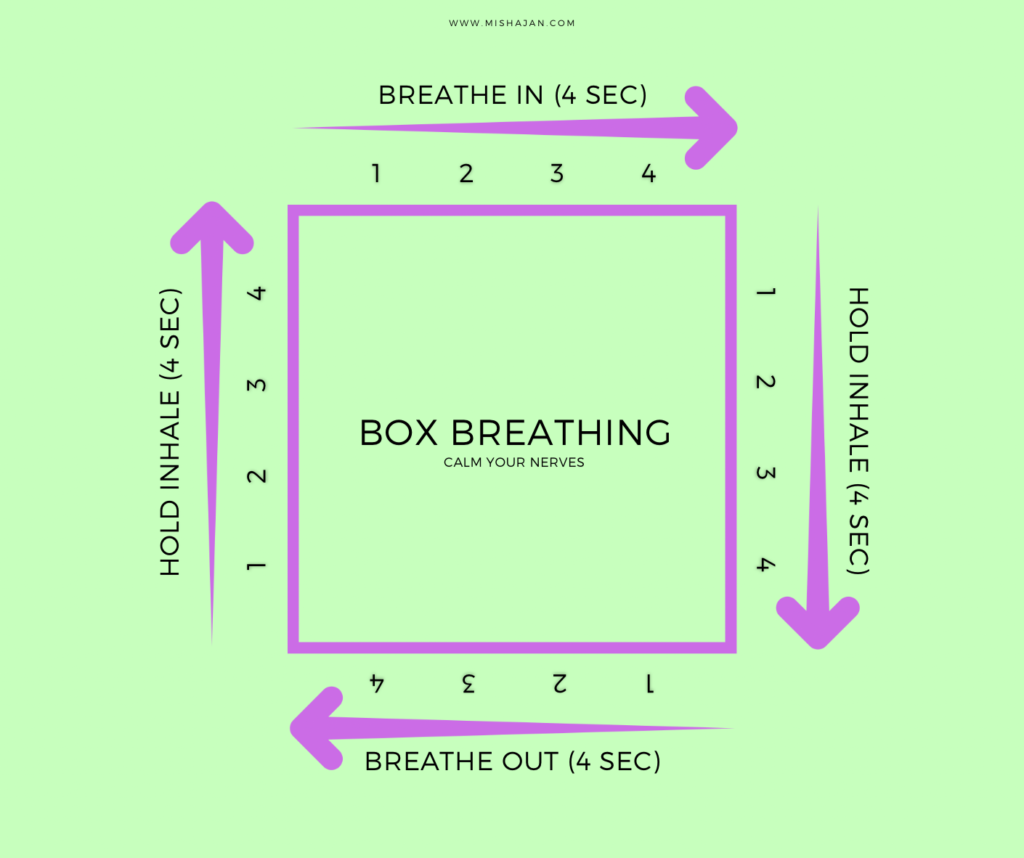We are mechanised by our breath, breathing on average over 22,000 times a day. Despite breathing being an essential bodily function the power of breath work often gets overlooked.
Yes, breathing in and out unconsciously will keep you alive, but breathing intentionally through diaphragmatic breathing, or box breathing, can help you thrive.
Notice your breath at this moment. How deep is your breath and how much are your lungs expanding? Perhaps your breath goes in and out of your chest in short breaths—this is called shallow breathing.
The goal with box breathing is to allow more air to fill up the lungs.
This is called deep breathing. Take a long and slow breath down into your diaphragm and allow your lungs to expand full of air.
Box Breathing
There are four steps to box breathing and each step is equally important and contains its own set of benefits.

Step 1: Breathe in
Slowly inhale through your nose for four seconds, breathing in deeply and allowing your lungs to fill up fully. This will slow your heart rate.
Step 2: Hold inhale
Now that your lungs are full, do not exhale right away. Pause and hold your breath for four seconds, allowing oxygen to enter the bloodstream and carbon dioxide to enter the lungs.
Step 3: Breathe out
Avoid releasing all your air at once. Instead, slowly and evenly breathe through your mouth out for four seconds. Doing so will activate the parasympathetic nervous system and the vagus nerve relaxing your body and mind.
Step 4: Hold exhale
Again, hold your breath and pause for four seconds. After four seconds, repeat step one. The goal is to go through this cycle at least four times. The longer you can practice, the better.
The benefits
In addition to overall relaxation, diaphragmatic breathing exercises encompass a wide variety of overall health benefits.
- Improved mood
Box breathing activates the vagus nerve, which is correlated with decreased feelings of depression and anxiety and is often referred to as the “key to health” in popular health culture
- Instant anxiety relief and stress resilience
During panic attacks, the sympathetic nervous system (in charge of fight, flight or freeze) is activated and cortisol is dumped into our bloodstream. With consistent box breathing practice, the body decreases sympathetic nervous system activity. This teaches the body to stay calm in moments of difficulty.
Researchers have found that just one session of slow diaphragmatic breathing reduces anxiety levels and activates the parasympathetic nervous system which allows the mind and body to relax.
- Increased cognitive performance
By remaining physiologically relaxed in adverse scenarios, you will be able to make better decisions. Studies show that taking deep diaphragmatic breaths allows for mental clarity and increases attentiveness, resulting in overall increased cognitive performance.
If you are ever feeling stressed during an exam, notice your heart rate going up when meeting new people, or are in a situation that is bringing up anxiety, try box breathing and experience the mental clarity and relaxation that comes along with it.
Practice this method daily to reap the benefits. You can practice box breathing anywhere, anytime, so give it a try!
Feature graphic by Angel Xing




